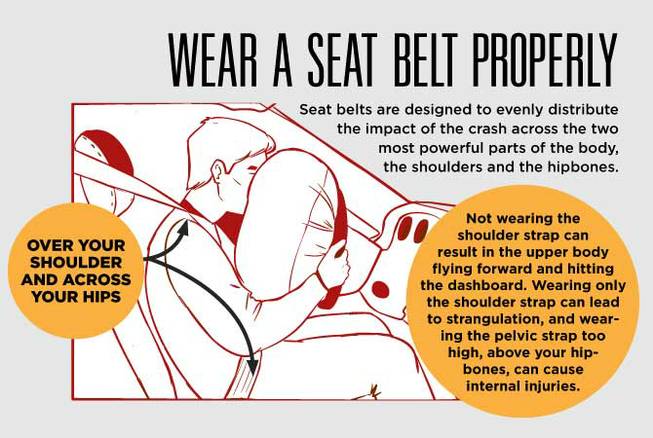
Sunday, May 17, 2015 | 2 a.m.
While cars become safer each year because of diligent crash testing and higher safety standards, the seat belt continues to be the gold standard for passenger safety. Wearing a seat belt reduces the risk of being seriously injured or killed in a crash by up to 50 percent. While many people take seat belts for granted — in 2013, 46 percent of people killed in Nevada motor vehicle crashes were not buckled up — wearing a seat belt consistently is a fundamental requirement for safe driving.
Wear a seat belt properly — over your shoulder and across your hips.
Seat belts are designed to evenly distribute the impact of the crash across the two most powerful parts of the body, the shoulders and the hipbones. Wearing a seat belt improperly severely limits its effectiveness. Not wearing the shoulder strap can result in the upper body flying forward and hitting the dashboard. Wearing only the shoulder strap can lead to strangulation, and wearing the pelvic strap too high, above your hipbones, can cause internal injuries.
How do seat belts work?
Seat belts are made of extremely durable polyester webbing. There are approximately 300 fibers woven into a single belt, and each can hold up to 3 tons. They also have load limiters, which help minimize potential seat belt injuries. In severe crashes, a passenger can be pushed by the seat belt hard enough to cause damage, so load limiters release some of the locking tension when enough force is applied to the belt. Load limiters can be as simple as a fold sewn into the belt, with stiches designed to break under force, or far more advanced.
Failing to wear a seatbelt can hurt others, too
Every passenger in a car must a wear seat belt or increase the risk of hurting not only themselves but others, too. Riders can be thrown around within a vehicle and can collide with one another, causing serious injury. For instance, if a backseat passenger on the left side of the car isn’t wearing a seat belt, during a crash, the passenger could be thrown into the back of the driver’s seat. That could cause the driver’s seat belt to fail and could lead to severe injury or death for both the driver and the passenger.
The law of Inertia contributes to the force of a crash
Inertia, or an object’s resistance to changing speeds, can send someone hurling from a car during a crash. Inertia wants to keep a moving vehicle moving at the same speed, in the same direction, until something stops it. When you’re in a car, it may seem as though you and the vehicle are a single unit, but each object has its own inertia.
While safely driving, your inertia is the same as the car’s
While passengers in a car maintain their own inertia separate from the vehicle’s, they also assume the same speed as the car. That means, if the car comes to an abrupt stop, passengers still will be traveling at the same speed the car was, until something stops them, too.
During a crash, your inertia continues while the car’s inertia stops
If a car traveling 50 mph crashes into a brick wall, the force of the wall will bring the car to an immediate stop. But anything in the car will continue moving at 50 mph until it also meets enough resistance to slow down. If a rider is wearing a seat belt, it will be the force that slows him down first. If he isn’t, something else would have to slow him down —often the airbag, dashboard or windshield.
How much inertia does your body have?
Imagine the force of a car hitting a wall at 50 mph — that’s how hard your head would hit the windshield if you’re weren’t wearing a seat belt. When you’re buckled up, your inertia is absorbed by the car, not your windshield.
Driving safely
1. The law of inertia contributes to the force of a crash
Inertia, or an object’s resistance to changing speeds, can send someone hurling from a car during a crash. Inertia wants to keep a moving vehicle moving at the same speed, in the same direction, until something stops it. When you’re in a car, it may seem as though you and the vehicle are a single unit, but each object has its own inertia.
2. While safely driving, your inertia is the same as the car’s
While passengers in a car maintain their own inertia separate from the vehicle’s, they also assume the same speed as the car. That means, if the car comes to an abrupt stop, passengers still will be traveling at the same speed the car was, until something stops them, too.
3. During a crash, your inertia continues while the car’s inertia stops
If a car traveling 50 mph crashes into a brick wall, the force of the wall will bring the car to an immediate stop. But anything in the car will continue moving at 50 mph until it also meets enough resistance to slow down. If a rider is wearing a seat belt, it will be the force that slows him down first. If he isn’t, something else would have to slow him down —often the airbag, dashboard or windshield.
4. How much inertia does your body have?
Imagine the force of a car hitting a wall at 50 mph — that’s how hard your head would hit the windshield if you’re weren’t wearing a seat belt. When you’re buckled up, your inertia is absorbed by the car, not your windshield.

Join the Discussion:
Check this out for a full explanation of our conversion to the LiveFyre commenting system and instructions on how to sign up for an account.
Full comments policy